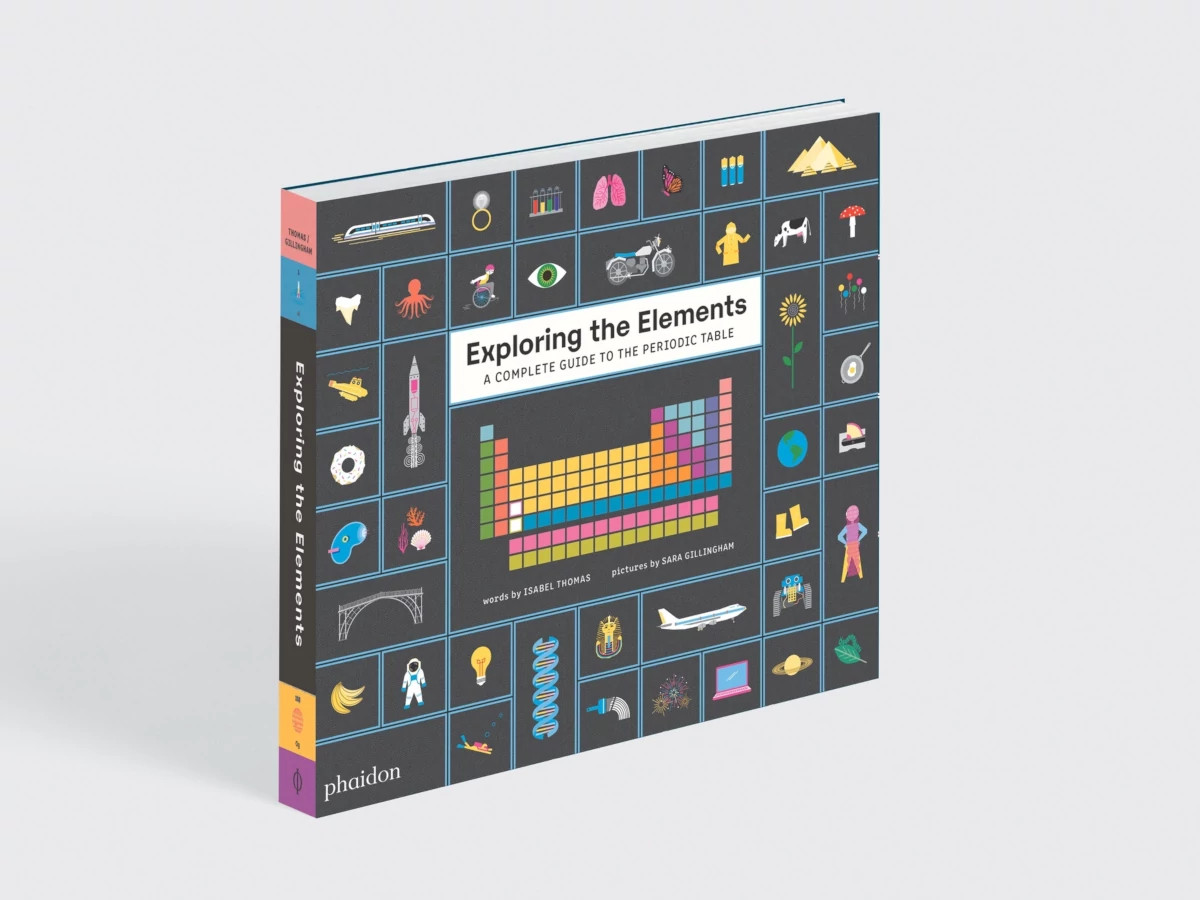Exploring the Elements: A Complete Guide to the Periodic Table
We are all made up of atoms, a combination of atoms of elements. Elements that can be organized in a variety of ways. But the most recognized way, today, is arranged according to the Periodic Table of Elements. We all learned about it in school, and some of us still actually remember what all the numbers mean, why the elements are in the columns that they are, and what the heck a noble gas is. But it’s always a good time to teach the next generation about the elements, and a new book that came out last month is a fun one to do it with.
Though it’s aimed at ages 8-14, Exploring the Elements: A Complete Guide to the Periodic Table, written by Isabel Thomas and illustrated by Sara Gillingham, will teach people of all ages something new. (I’ll bet you don’t already know where you can find Tellurium!)
After an overview of atoms and the Periodic Table and its groups and periods, the book gives a brief overview of where you can find a lot of the elements, such as in parts of Earth itself, in the human body, and inside technology. Then there’s a handy diagram of how to use the book and how to read each of the elements’ pages, complete with a key and list of handy symbols to look for, such as “toxic,” “radioactive,” and “ferromagnetic.”
Though it begins with hydrogen, it doesn’t go through the Periodic Table in order, instead grouping the elements into their types, such as alkali metals, halogens, noble gases, and superheavy elements. This makes it easier for readers to learn what each group has in common, and how the elements inside the group differ from each other. Sections of the book are colored by type, making it easy to find what you’re looking for.
The back of the book includes some short-but-handy sections on A History of Exploring the Elements; Questions About Atoms, Elements, and Compounds; Properties of the Elements (including melting and boiling points, density, and average atomic mass); glossary; other resources; and an index.
The book includes 118 elements, including the 92 found in nature and 26 more made by humans. Each element itself receives a 1/2-to-2-page treatment, depending on how much there is to say about it that would interest your average kid. But each includes its atomic number and symbol, where it is located on the table, its key properties, where it is found in the world, how much (if any) is found in the human body, how its electrons are arranged, and two sections that are filled with interesting information: the story of the element and its significance to humans, and a box that dives into why each element behaves the way it does. Some of the less-exciting elements don’t contain all of these features, and some include an additional Forms and Uses section. Additionally, the inside of the dust jacket displays the Periodic Table itself, as well as descriptions of the element categories and a list of when each element was discovered.
All in all, Exploring the Elements is a fun and easily-digestible way for your elementary or middle schooler to learn about the elements that make up matter, either individually or in element groups. Plus, grown-ups will learn something as well. The affordable price, colorful pages, and well-organized information certainly don’t hurt, either!

A Slice Through America: A Geological Atlas
You know when you’re driving along the highway through hilly terrain and there are road cuts to make the road less hilly? The geology lovers among us really enjoy seeing in those road cuts all the layers of earth that have piled up and been folded or uplifted, or even slid along each other because of faults.
A Slice Through America: A Geological Atlas by David Kassel takes a look at different areas of the continental U.S. through this kind of lens, what cross sections of the Earth’s crust look like in different locations through stratigraphic diagrams. Though the table of contents seems to include many errors, the actual contents of the book is fantastic.
Because geologic time is slow, and geological processes are constantly changing the Earth’s crust, these diagrams are only a snapshot in time. But they give a good idea of how our landscape came to look like it does, and highlight the many differences in land formation across the country. As the preface reminds us, “…the layers are not necessarily in sequential order. There are huge forces at work disrupting a linear narrative.” It’s up to us to unravel the mystery of how the crust came to look as it does, or to just enjoy not knowing.
Assembled by someone who, admittedly, is not a geologist (he’s more of an art collector), it’s still easy to take in the beauty and wonder of these diagrams and maps. And geologists and fans of geology (raises hand) will recognize the fundamental principles of stratigraphy, such as superposition, original horizontality, and lateral continuity. Like Newton’s or Kepler’s laws, these “laws” put forth by Nicolaus Steno in the 1600s help us understand the formation of what we see in Earth’s crust layers. Synclines, anticlines, and historical weathering are all easily noticed in these diagrams.
The Introduction to the book, written by sedimentary geologist Jody Bourgeois, includes a bit of a history of geologic study with names, dates, and theories abounding. But most of the book consists of the plates with modest captions. The plates originate from the 1800s to the present day—with many being created in the 1960s and 1980s—and were drawn by federal and state geologists.
I wish Kassel had partnered with a professional geologist to write more in-depth information about what you’re seeing in each plate, including a map of exactly where in the country the cross-section is from. Younger children will enjoy looking at the colorful diagrams, but older children and adults will get more out of it, especially those who have already taken at least a basic Earth Science or Geology class and understand what they are seeing.
A Slice Through America is a bit pricier than the first book in this post, but it takes a lovely view at the study and history of cross-sectional geology.
Note: I received both books for review purposes, but all opinions are my own. This post contains affiliate links.





These are gorgeous! We recently got the small Usborne Periodic Table of Elements booklet with the puzzle, and need more. Thank you.